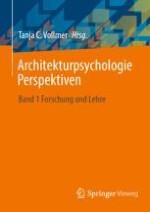2023 | OriginalPaper | Chapter
5. Architekturpsychologie an der Süddänischen Universität
Author : Kirsten K. Roessler
Published in: Architekturpsychologie Perspektiven
Publisher: Springer Fachmedien Wiesbaden
Activate our intelligent search to find suitable subject content or patents.
Select sections of text to find matching patents with Artificial Intelligence. powered by
Select sections of text to find additional relevant content using AI-assisted search. powered by
